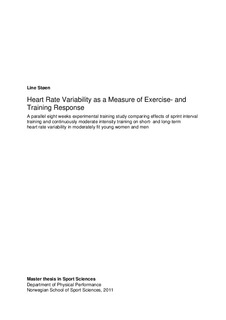| dc.description.abstract | Aims: Heart rate variability (HRV) is proposed to be a measure of cardiac autonomic activity.
This study was designed to investigate the short- and long-term HRV before, during and after
eight weeks (3x/week) of sprint interval training (SIT), compared to eight weeks (3x/week) of
continuously moderate intensity training (CT) in young and healthy women and men, and to
examine associations between HRV and response in maximal oxygen consumption (VO2max).
Methods: 22 moderately fit young subjects were divided into the two groups, matched on
VO2max, sex and weight. Both groups did three sessions per week, and training were carried out
outside. SIT (four males, eight females) did 5-10, 30-seconds near maximal intensity runs in a
graded track, with three minutes of rest (passive walking) between bouts. CT (thee males,
seven females) ran at 70-80% of their HRpeak for 30-60 minutes on each session.
During the training period, subjects did two short-term recordings of HRV, measured at rest in
the morning (five minutes of sitting, followed by five minutes of standing). Recordings were done
after training days (AT) and after resting days (AR). Pre-, mid- and post training subjects
performed a test of VO2max and a 24-hour recording of HRV (long-term). R-R intervals were
recorded using a hear rate monitor Polar RS800CX, Polar Electro Oy, Kempele, Finland) and RR
data were analyzed in Hearts software. HRV indices included are time-domain (mean HR,
SDNN), frequency-domain (LF, HF and LF/HF ratio) and non linear analysis (Poincaré Plot; SD1
and SD2, α1, APEN). Data are presented as means ± SEM. Short-term data were analyzed for
AR and AT in three sub periods (period 1: week 0-2, period 2: week 3-5, period 3: week 6-9).
Long-term data were analyzed for the whole 24-hour period and separate for night hours (1-5
a.m.).
Results: In SIT, HRV was significantly lower on AT days compared to AR days both in sitting
and standing posture during the first training weeks. These changes were not observed in
period 2 and 3. From period 1 to period 3, SIT showed a significant decrease in HRV on AR
days in standing posture (p < 0.05), and tended to decrease also in sitting posture. In CT, no
changes were observed between AT and AR or between periods. We found no increase in 24-
hours HRV post training. Both groups increased VO2max; 2.4 ± 0.7 and 2.0 ± 0.9 ml kg-1 min-1 for
SIT and CT respectively (p <0.05). We found a significant correlation between changes in shortterm
HF power, (ln, ms2) on AR days in sitting posture and training response (ΔVO 2max) for both
groups together (r=0.531, p=0.011) and for SIT group alone (r=0.615, p=0.033).
Conclusion: It can be concluded that during the first weeks of SIT, HRV is lower after training
days compared to after resting days. Furthermore, a lower HRV after resting days appears
during the last weeks of SIT, indicating a withdrawal in cardiac vagal activity and a training
overload. On the contrary, during an eight weeks period of CT, HRV do not change after training
days compared to after resting days. Although SIT and CT are efficient to increase VO2max, our
data do not support benefits on HRV in moderately fit young women and men. However, HRV
can be a valuable tool to evaluate the long-term recovery of and for planning a proper training
load in moderately fit subjects. | en_US |
